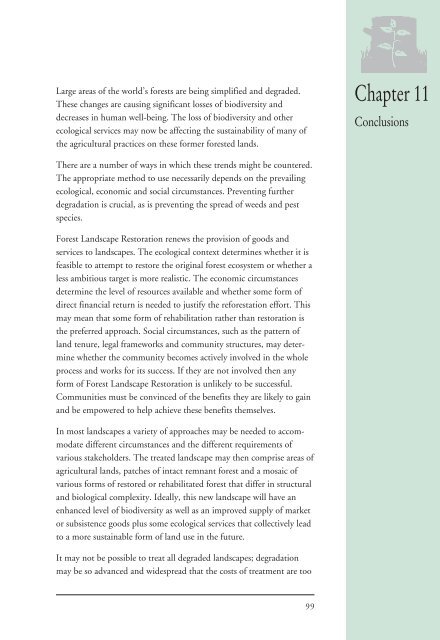Rehabilitation and Restoration Of Degraded Forests (PDF) - IUCN
Rehabilitation and Restoration Of Degraded Forests (PDF) - IUCN
Rehabilitation and Restoration Of Degraded Forests (PDF) - IUCN
Create successful ePaper yourself
Turn your PDF publications into a flip-book with our unique Google optimized e-Paper software.
Chapter 11: Conclusions<br />
Large areas of the world’s forests are being simplified <strong>and</strong> degraded.<br />
These changes are causing significant losses of biodiversity <strong>and</strong><br />
decreases in human well-being. The loss of biodiversity <strong>and</strong> other<br />
ecological services may now be affecting the sustainability of many of<br />
the agricultural practices on these former forested l<strong>and</strong>s.<br />
There are a number of ways in which these trends might be countered.<br />
The appropriate method to use necessarily depends on the prevailing<br />
ecological, economic <strong>and</strong> social circumstances. Preventing further<br />
degradation is crucial, as is preventing the spread of weeds <strong>and</strong> pest<br />
species.<br />
Forest L<strong>and</strong>scape <strong>Restoration</strong> renews the provision of goods <strong>and</strong><br />
services to l<strong>and</strong>scapes. The ecological context determines whether it is<br />
feasible to attempt to restore the original forest ecosystem or whether a<br />
less ambitious target is more realistic. The economic circumstances<br />
determine the level of resources available <strong>and</strong> whether some form of<br />
direct financial return is needed to justify the reforestation effort. This<br />
may mean that some form of rehabilitation rather than restoration is<br />
the preferred approach. Social circumstances, such as the pattern of<br />
l<strong>and</strong> tenure, legal frameworks <strong>and</strong> community structures, may determine<br />
whether the community becomes actively involved in the whole<br />
process <strong>and</strong> works for its success. If they are not involved then any<br />
form of Forest L<strong>and</strong>scape <strong>Restoration</strong> is unlikely to be successful.<br />
Communities must be convinced of the benefits they are likely to gain<br />
<strong>and</strong> be empowered to help achieve these benefits themselves.<br />
In most l<strong>and</strong>scapes a variety of approaches may be needed to accommodate<br />
different circumstances <strong>and</strong> the different requirements of<br />
various stakeholders. The treated l<strong>and</strong>scape may then comprise areas of<br />
agricultural l<strong>and</strong>s, patches of intact remnant forest <strong>and</strong> a mosaic of<br />
various forms of restored or rehabilitated forest that differ in structural<br />
<strong>and</strong> biological complexity. Ideally, this new l<strong>and</strong>scape will have an<br />
enhanced level of biodiversity as well as an improved supply of market<br />
or subsistence goods plus some ecological services that collectively lead<br />
to a more sustainable form of l<strong>and</strong> use in the future.<br />
It may not be possible to treat all degraded l<strong>and</strong>scapes; degradation<br />
may be so advanced <strong>and</strong> widespread that the costs of treatment are too<br />
99<br />
Chapter 11<br />
Conclusions

















